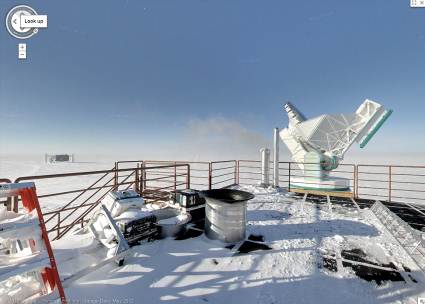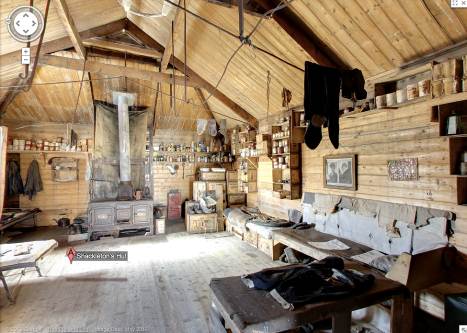Panoramic images of the Antarctic: now everyone can become a polar explorer!
Alex Starns, Technical Program Manager, Street View
In the distant winter of 1913, one of the British newspapers published an advertising message about the organization of the next imperial expedition to the Antarctic. It read: “I am looking for those who want to go on a dangerous journey. Low salary, penetrating cold, long hours of pitch darkness. A small chance for a successful return. If successful, the heroes will receive honors and recognition. Ernest Shackleton. The authenticity of this announcement is still questionable, but the danger of traveling to the South Pole is beyond doubt. Many researchers, who were trying to be among the first at the South Pole, were convinced of this experience. Among them: Roald Amundsen, Robert Falcon Scott and Ernest Shackleton.
In September 2010, we launched the first panoramic images of the Antarctic , thanks to which users could get to know the Antarctic penguins. Today, we present to your attention additional images of historically significant sites in Antarctica, a collection of which will be posted on the World Wonders project website. There you will find more detailed information on the history of the development of the South Pole, without leaving your comfortable chair.
')
Thanks to the collaboration with the Polar Center for Geospatial Data at the University of Minnesota and the New Zealand Antarctic Heritage Foundation, we were able to expand the continental base of panoramic images and made available to study online many interesting and important places, such as the South Pole Telescope , Shackleton Hut, Scott Hut and Cape Royds, home to the Adelie penguin colony .

South Pole Telescope

The interior of Shackleton Hut, reflecting the real conditions of life in the Antarctic expeditions of the early 20th century. Everything has been preserved in the room, from medicine and food to candles and cargo sleds.
Thanks to modern technology, you can look into Shackleton's Hut and other small wooden buildings that were the only protection of polar explorers from extreme weather conditions. They were used for only a few years, but today, about a century later, they have remained almost unchanged along with the furnishings and household items inside.

Panorama around Scott's Hut. For early Antarctic researchers, such transit points with vital reserves were the only sources of warmth and comfort in these cold and inhospitable places.
New panoramic shots were made with an ultra wide-angle camera on a portable tripod. This technology is simple and reliable. The trikes , which we often use for shooting, would hardly be useful in such snowy places.
The goal of this project is to provide research scientists and nature lovers and travelers around the world with access to the most accurate information about important places in the South Pole. Thanks to clear high-resolution images, schoolchildren will be able to count the number of penguin colonies on Snow Hill Island, and geologists will study the Dry Valleys right on the computer screen.
Take an exciting trip to Antarctica. You will not need felt boots and mittens!

In the distant winter of 1913, one of the British newspapers published an advertising message about the organization of the next imperial expedition to the Antarctic. It read: “I am looking for those who want to go on a dangerous journey. Low salary, penetrating cold, long hours of pitch darkness. A small chance for a successful return. If successful, the heroes will receive honors and recognition. Ernest Shackleton. The authenticity of this announcement is still questionable, but the danger of traveling to the South Pole is beyond doubt. Many researchers, who were trying to be among the first at the South Pole, were convinced of this experience. Among them: Roald Amundsen, Robert Falcon Scott and Ernest Shackleton.
In September 2010, we launched the first panoramic images of the Antarctic , thanks to which users could get to know the Antarctic penguins. Today, we present to your attention additional images of historically significant sites in Antarctica, a collection of which will be posted on the World Wonders project website. There you will find more detailed information on the history of the development of the South Pole, without leaving your comfortable chair.
')
Thanks to the collaboration with the Polar Center for Geospatial Data at the University of Minnesota and the New Zealand Antarctic Heritage Foundation, we were able to expand the continental base of panoramic images and made available to study online many interesting and important places, such as the South Pole Telescope , Shackleton Hut, Scott Hut and Cape Royds, home to the Adelie penguin colony .

South Pole Telescope

The interior of Shackleton Hut, reflecting the real conditions of life in the Antarctic expeditions of the early 20th century. Everything has been preserved in the room, from medicine and food to candles and cargo sleds.
Thanks to modern technology, you can look into Shackleton's Hut and other small wooden buildings that were the only protection of polar explorers from extreme weather conditions. They were used for only a few years, but today, about a century later, they have remained almost unchanged along with the furnishings and household items inside.

Panorama around Scott's Hut. For early Antarctic researchers, such transit points with vital reserves were the only sources of warmth and comfort in these cold and inhospitable places.
New panoramic shots were made with an ultra wide-angle camera on a portable tripod. This technology is simple and reliable. The trikes , which we often use for shooting, would hardly be useful in such snowy places.
The goal of this project is to provide research scientists and nature lovers and travelers around the world with access to the most accurate information about important places in the South Pole. Thanks to clear high-resolution images, schoolchildren will be able to count the number of penguin colonies on Snow Hill Island, and geologists will study the Dry Valleys right on the computer screen.
Take an exciting trip to Antarctica. You will not need felt boots and mittens!
Source: https://habr.com/ru/post/148195/
All Articles